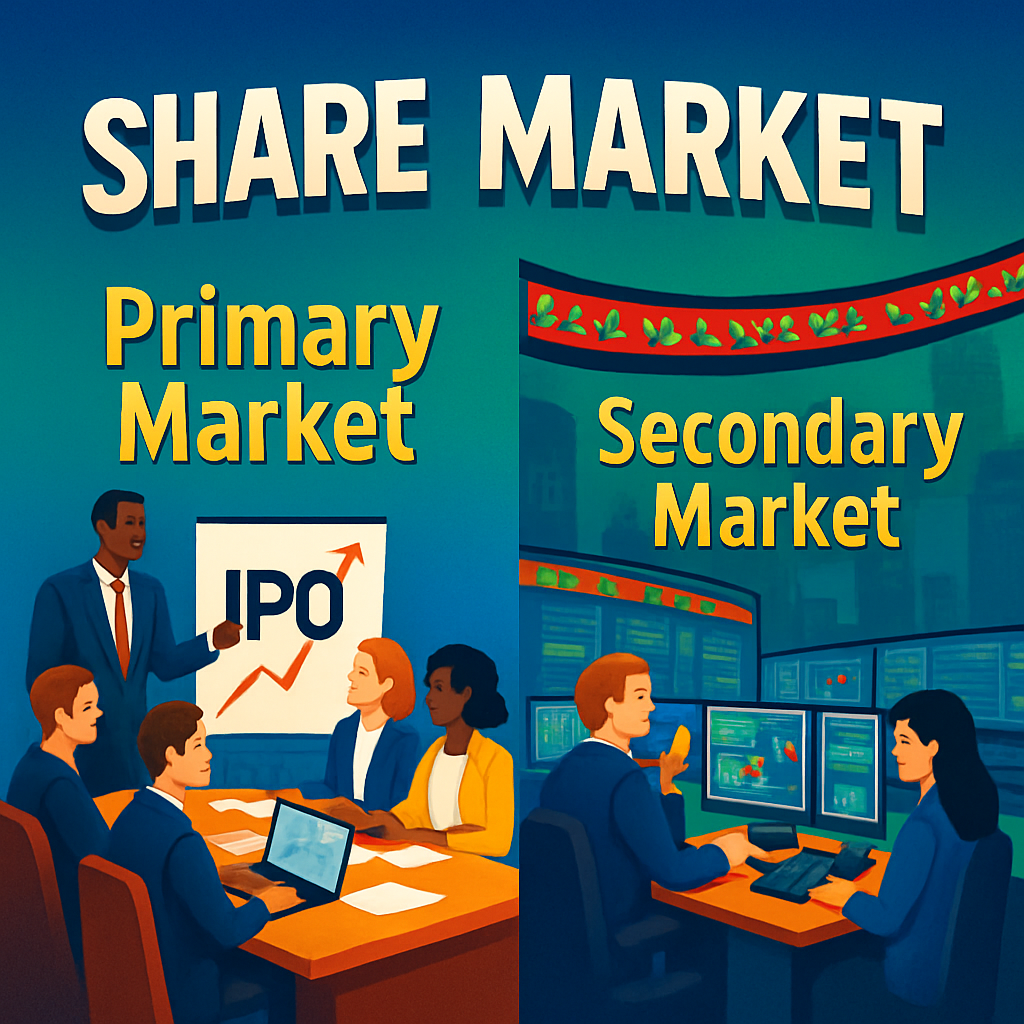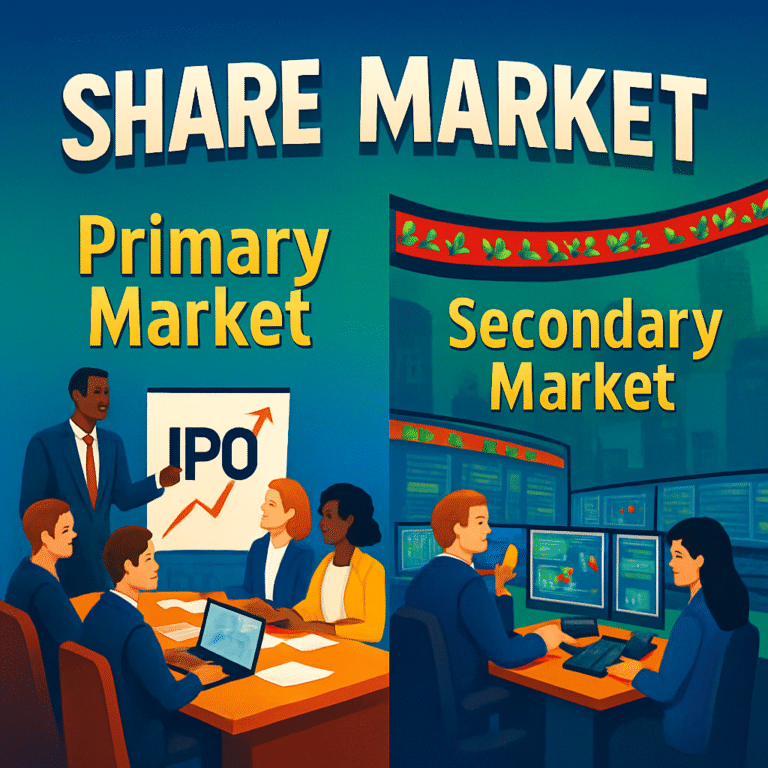
The share market (also known as the stock market or equity market) is a marketplace—physical or digital—where ownership units in companies, called shares, are bought and sold. It helps companies raise capital and enables investors to participate in corporate growth and earn returns via price appreciation or dividends. Here’s a clear breakdown:
🏦 1. Primary Market (New-Issue/IPO Market)
What it is: The place where new securities (stocks, bonds) are issued and sold for the first time, directly by companies or governments to investors.
How it works: Through processes like IPOs, private placements, rights issues, or bond issuances. Underwriters (usually investment banks) help price and sell these offerings
Who benefits: The issuing entity—the only one that receives the proceeds—to fund business expansion, repay debt, or invest in new projects
Key features:
- Only new securities are sold.
- Prices typically set in advance by issuer and underwriters.
- Often includes lock-up periods for internal stakeholders (e.g. founders, employees)
📊 Types of Primary Market Issuances
- Initial Public Offering (IPO)
- – Company offers shares to the public for the first time
- Follow-on or Secondary Public Offer (FPO)
- – Already-listed companies issue additional shares to raise more capital
- Rights Issue
- – Existing shareholders get discounted rights to purchase new shares in proportion to their current holdings
- Private Placement
- – Shares offered directly to select institutional or accredited investors, not the public
- Preferential Allotment
- – Shares issued to a specific group at a chosen price, outside of public markets
✅ Key Functions of the Primary Market
- 🏦 Capital Raising: Enables companies and governments to fund expansion, R&D, debt repayment, and projects
- 💰 Underwriting: Underwriters guarantee the sale of securities, assuming risk and facilitating distribution
- 📰 Price Discovery & Transparency: Investment banks set initial prices based on company fundamentals and demand; regulated via disclosures (e.g., prospectus)
- 🌱 Economic Growth: By channeling savings into corporate or government activities, the market supports development and employment
⚠️ Advantages & Limitations
👍 Advantages
- Enables capital infusion into growing companies or government ventures
- Offers investors the chance to enter early at discounted prices
- Deliver regulatory transparency through SEBI/SEC-regulated disclosures and filings .
👎 Limitations
- Lack of liquidity: newly issued shares may be locked-up before trading begins
- Higher costs: Underwriting, legal, and regulatory expenses can be significant
- Market risk: Subscription levels, economic conditions, or inappropriate pricing can affect outcomes .
🔄 2. Secondary Market (Aftermarket)
- What it is: The marketplace where already-issued securities are traded between investors, without involvement of the issuing company.
- How it works: Investors buy and sell shares through stock exchanges (like BSE, NSE, NYSE, Nasdaq) or over-the-counter (OTC) platforms.
- Who benefits: The selling investor receives the proceeds, not the issuing company.
- Key features:
- High liquidity—investors can quickly convert holdings into cash.
- Prices are determined by supply and demand, reflecting market sentiment and company performance
- Enables price discovery and helps maintain investor confidence in the primary market
Key Features
1. Investor-to-Investor Trading
- When you buy shares on an exchange, you’re purchasing from another investor—not from the issuing
2. Price Discovery
- Ongoing buying and selling establish a security’s market price, reflecting supply and demand dynamics
3. Liquidity
- You can convert holdings into cash quickly, thanks to the secondary market’s active nature
4. Market Efficiency
- Freely traded prices ensure efficient allocation of capital, enabling investors to enter and exit positions easily
Types of Secondary Markets
- Exchange-based (Auction markets)
Centralized venues like NYSE, NSE, BSE—buyers and sellers match orders - Dealer or OTC Markets
Transactions occur via brokers or dealers holding security inventories, e.g., Pink Sheets, OTCBB - Specialized Secondary Markets
Includes markets for mortgages, asset-backed securities, or private-equity secondaries (e.g., fund stakes)—though access can be limited
📊 Primary vs. Secondary Market at a Glance
| Feature | Primary Market | Secondary Market |
|---|---|---|
| Trading Parties | Issuer ↔ Investors | Investor ↔ Investor |
| Purpose | Raise funds for issuer | Provide liquidity to investors |
| Price Setting | Set by issuer/underwriters | Set by market forces (supply & demand) |
| Funds Recipient | Issuer (company/government) | Selling investor |
| Liquidity Level | Limited to issuance event | High; ongoing daily trading |
| Regulation Level | Extensive disclosure & regulation | Regulated, but less stringent |
Why Both Markets Important
- Primary market enables companies and governments to raise fresh capital.
- Secondary market provides Liquidity & exit paths: Ensures investors can buy or sell any time.
- Secondary market provides Fair pricing: Reflects real-time investor sentiment and market conditions.
- Secondary market provides Supports new issuance: Strengthens primary markets by assuring future tradability
- Together, both markets support capital formation, economic growth, and wealth creation
Summary
- The primary market is where new securities are initially issued to raise capital.
- The secondary market is where those securities are then traded among investors, ensuring liquidity and price discovery.







